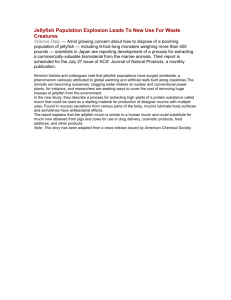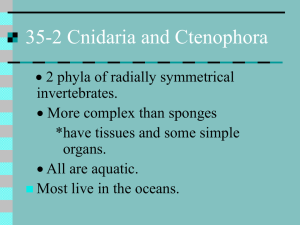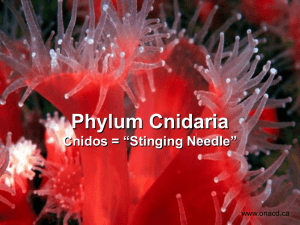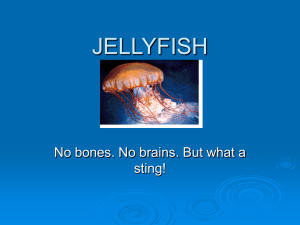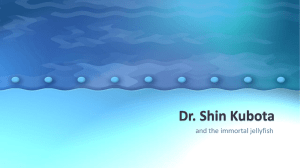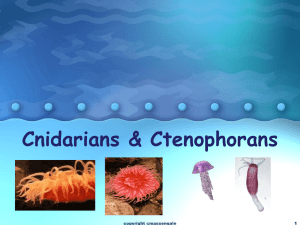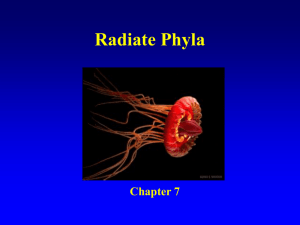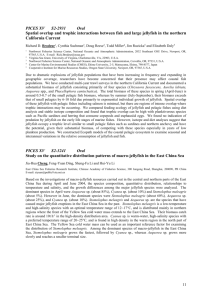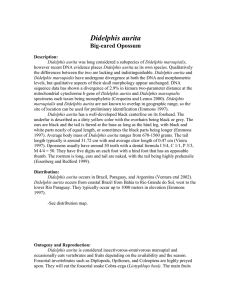The effect of temperature increase on moon jellyfish, Arelia aurita
advertisement
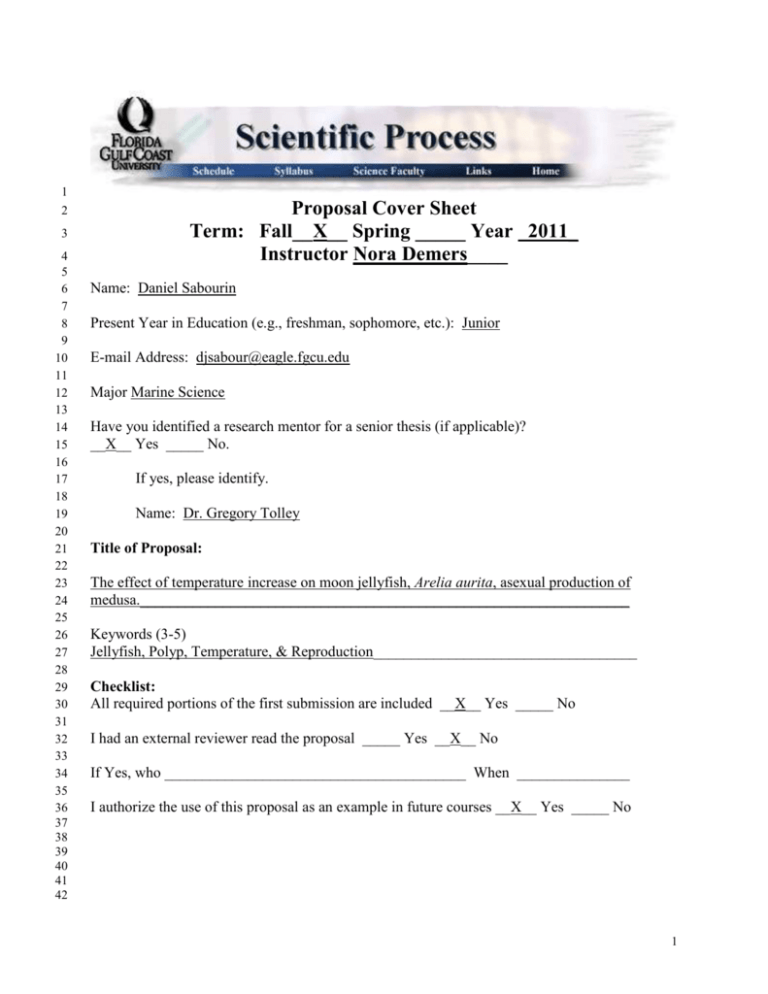
1 2 3 4 5 6 7 8 9 10 11 12 13 14 15 16 17 18 19 20 21 22 23 24 25 26 27 28 29 30 31 32 33 34 35 36 37 38 39 40 41 42 Proposal Cover Sheet Term: Fall__X__ Spring _____ Year 2011_ Instructor Nora Demers____ Name: Daniel Sabourin Present Year in Education (e.g., freshman, sophomore, etc.): Junior E-mail Address: djsabour@eagle.fgcu.edu Major Marine Science Have you identified a research mentor for a senior thesis (if applicable)? __X__ Yes _____ No. If yes, please identify. Name: Dr. Gregory Tolley Title of Proposal: The effect of temperature increase on moon jellyfish, Arelia aurita, asexual production of medusa._________________________________________________________________ Keywords (3-5) Jellyfish, Polyp, Temperature, & Reproduction___________________________________ Checklist: All required portions of the first submission are included __X__ Yes _____ No I had an external reviewer read the proposal _____ Yes __X__ No If Yes, who ________________________________________ When _______________ I authorize the use of this proposal as an example in future courses __X__ Yes _____ No 1 43 Abstract 44 45 Blooms in global jellyfish populations, while thought to be the result of changing oceanic 46 conditions that stem from global climate change, aren’t well understood. These blooms create 47 problems for fisheries and power plants that use ocean water for cooling. To better fill this gap 48 of knowledge, samples of moon jellyfish polyps, Aurelia aurita, will be collected and subjected 49 to water temperatures ranging from 26 to 34 degrees Celsius. Over the course of a year, samples 50 will be gathered and tested for temperature’s effect on medusa production. 51 52 53 54 55 56 57 58 59 60 61 62 63 64 65 2 66 67 68 69 70 71 72 73 74 75 76 77 78 79 80 81 82 83 84 85 86 87 Table of Contents I. Project Description……………………………………………………………………4 A) Statement of Problem……………………………………………………………..4 B) Research Objective………………………………………………………………..5 C) Methods…………………………………………………………………………...5 1) Study Design……………………………………………………………...5 a) Animal Field Sampling…………………………………………...5 b) Lab Experiment Design…………………………………………..6 2) Data Collection…………………………………………………………...6 3) Data Analysis……………………………………………………………..7 D) Broader Implications……………..………………………………………………7 E) Equipment Needed……………………………………………………………….8 F) Tentative Timeline……………………………………………………………….8 II. References Cited……………………………………………………………………..9 III. Appendix 1………………………………………………………………………….10 IV. Curriculum Vitae……………………………………………………………………11 88 89 90 91 92 93 94 95 96 97 98 99 3 100 Project Description 101 -Statement of Problem 102 103 In moderate numbers, the common moon jellyfish, Aurelia aurita, exhibit mutualistic 104 relationships with some fish, providing them with protection from larger species that would 105 predate them, and predatory relationships with most others through consumption of larvae and 106 indirect competition for resources (Tolley 1987). When jellyfish start to overpopulate in 107 proportion to nektonic fish, it becomes harmful for the fisheries as these gelatinous organisms 108 syphon off the flow of nutrients into “trophic dead ends” (Brodeur, Sugisaki, & Hunt 2002). 109 These medusae are produced by the polyp stage of their lifecycle. In optimal conditions, the 110 individual polyps can bud clones of themselves, which are capable of producing even more 111 medusa. 112 113 In oceans around the world, jellyfish have been increasing in population density (Shoji et 114 al. 2005(a&b)). Like most jellyfish species, A. aurita’s life cycle alters between the pelagic 115 medusa stage and the benthic polyp stage, the medusa being sexual and the polyp asexual (Shick 116 1975). Jellyfish are also capable of tolerating a wide range of dissolved oxygen content in water 117 (Shoji et al. 2005(a&b)). With rising ocean temperatures as a result of global climate change 118 (Walther et al. 2002), water capacity for dissolved oxygen will decrease as the average 119 temperatures increase, creating a hypoxic environment in which jellyfish can easily predate fish 120 and larvae (Shoji et al. 2005). 121 122 4 123 With this rise in oceanic temperature, knowing what effect it has on A. aurita 124 reproductive success would provide useful foresight as to how global climate change will affect 125 the fishing industry and the ocean’s ecological balance. Kawamura and Kubota (2008) examined 126 the effect of temperature and salinity on hydromedusa reproduction success, but there is still a 127 gap in how temperature affects scyphomedusa in their polyp stage. To fill in this gap of 128 knowledge is the goal of this proposed research by gathering A. aurita polyp samples and 129 subjecting them to a range of temperatures, keeping all other conditions consistent so as to 130 observe the effect of temperature alone on their production of medusa. 131 132 133 134 -Research Objective The purpose of this study is to examine the effect of temperature on the asexual production of medusa and polyps in moon jellyfish polyps, Aurelia aurita. 135 136 Methods 137 -Study Design 138 -Animal Field Sampling 139 140 A. aurita samples will be collected either through vertical tows from 2m above the 141 bottom to the surface using plankton nets at a haul speed of 1m per second, (Kawamura and 142 Kubota 2008) or from a self-sustaining aquatic tank in Marco Island with the Marriott’s 143 permission. Scyphistoma will be maintained in order to sustain life and prevent strobilation 144 (Appendix 1) in order to induce polyp budding (Shick 1975). 145 5 146 -Lab Experiment Design 147 148 Animals will be kept at room temperature (21-24°C) in iodine-free, 30psu artificial 149 seawater. Roughly 200 will be kept at controlled temperatures via microplate submersion in 150 temperature-controlled water baths (Fitt and Costley 1998). 100-200 asphyxiated Artemia nauplii 151 to feed each polyp (Kawamura and Kubota 2008). Maintenance methods call for feeding twice 152 weekly, having food residue removed after feeding; the polyps will be given 20 minutes to feed 153 before residue removal (Kawamura & Kubota 2008) and water will be changed after each 154 feeding on the day of feeding (Fitt and Costley 1998). Salinity of experiment medium will be 155 maintained at 30psu salinity while temperature will range from 26 to 34 degrees Celsius in 156 intervals of four degrees. 157 158 -Data Collection 159 160 Over the course of a year, polyp samples will be checked every other day for signs of 161 strobilation over a period of thirty days. Should strobilation occur, the number of released 162 ephyra will be tallied and removed from the medium. Asexual budding polyps will also be noted 163 and removed once separated from the parent polyp. 164 165 166 167 168 6 169 -Data Analysis 170 171 Statistical significance of the correlation between this data and temperature will be 172 examined using the Pearson product-moment correlation coefficient (Kobayashi & Kubota 173 2009). Then, only data possessing a strong correlation to temperature (r = 0.5 or greater) will be 174 further examined using a One-way Analysis Variance (ANOVA) to identify significance 175 between the data and temperature. 176 177 Broader Implications 178 179 Understanding the triggers that influence jellyfish population blooms affects two major 180 industries, fishing and power. The more jellyfish there are in the oceans, the more there are to 181 predate on larval fish, harming the fishing industry. Additionally, large populations also get 182 caught in currents created by nuclear power plants that use water for cooling, shutting down the 183 power plant until the intake is cleared. Finding the factors that promote jellyfish blooms will 184 allow for steps to be taken to prevent future blooms, thus improving conditions for nuclear plants 185 and the fishing industry. 186 187 188 189 190 191 7 192 Equipment Needed 193 194 For conduction of this experiment, the necessary equipment includes: one plankton net of 195 0.33mm mesh size, 24-well microplates, a supply of asphyxiated Artemia nauplii (Kawamura & 196 Kubota 2008), Instant Ocean seawater mix, and temperature-controlled water baths (Fitt & 197 Costley 1997). 198 199 Tentative Timeline 200 201 At the start of the Fall 2012 semester, the Marriott in Marco Isle will be contacted. If 202 polyp samples cannot be obtained from their Aurelia tank, arrangements will be made to obtain 203 samples in field. Over the course of one year, samples will be collected and maintained for 204 temperature experiments. At the conclusion of one year, Fall 2013, all data pertaining to 205 temperature experiments on asexual polyp production will be compiled for data analysis. 206 207 208 209 210 211 212 213 214 8 215 References Cited 216 217 218 219 220 221 222 223 224 225 226 227 228 229 230 231 232 233 234 235 236 237 238 239 240 241 242 243 244 245 246 247 248 249 250 251 252 253 254 Brodeur. R.D., H. Sugisaki, G.L. Hunt Jr. 2002. Increases in jellyfish biomass in the Bearing Sea: implications for the ecosystem. Marine Ecology Progress Series. Vol:233: 89-103. Fitt. W.K., K. Costley. 1998. The role of temperature in survivial of the polyp stage of tropical rhizostome jellyfish Cassiopea xamachana. Journal of Experimental Marine Biology and Ecology. Vol:222. 79-91. Kawamura, M., S. Kubota. 2008. Influences of temperature and salinity on asexual budding by hydromedusa Proboscidactyla ornate (Cnidaria: Hydrozoa: Proboscidactylidae). Marine Biological Association of the United Kingdom. Vol:88. 1601-1606. Kobayashi. A., S. Kubota. 2009. Relation between expanding range of bivalve-inhabiting hydrozoans and water temperature. Biogeography. Vol:11. 23-31. Richardson. A., A. Bakun, G. C. Hays, & M. J. Gibbons. 2009. The jellyfish joyride: causes and consequences and management responses to a more gelatinous future. Trends in Ecology & Evolution. Vol:24, Iss:6, June, 312-322. Shick, J.M., 1975. Uptake and utilixation of dissolved glycine by Aurelia aurita scyphistomae: Temperature effects on the uptake process; nutritional role of dissolved amino acids. Biol. Bull. Vol:148. 117-140. (a)Shoji. J., R. Masuda, Y. Yamashita, & M. Tanaka. 2005. Predation on fish larvae by moon jellyfish Aurelia aurita under low dissolved oxygen concentrations. Fisheries Science. Vol:71. 748-753. (b)Shoji. J., R. Masuda, Y. Yamashita, M. Tanaka. 2005. Effect of low dissolved oxygen concentrations on behavior and predation rates on red sea breams Pagrus major larvae by the jellyfish Aurelia aurita and by juvenile Spanish mackerel Scomberomorus niphonius. Marine Biology. Vol:147. 863-868. Tolley. S.G., 1987. Association of young chloroscombrus chrysurus (Pisces: Carangidae) with the jellyfish Aurelia aurita. Copeia. Vol:1. 216-219. Walther. G.R., E. Post, P. Convey, A. Menzel, C. Parmesan, T.J.C. Beebee, J.M. Fromentin, O. Hoeg-Guldberg, F. Bairlein. 2002. Ecological responses to recent climate change. Nature. Vol:416, 389-395. 255 256 9 257 Appendix 1 258 259 260 261 262 263 264 265 266 267 268 269 270 271 272 273 274 275 276 277 278 279 280 281 282 283 284 Muller. D. 2008. Scientific Illustration. http://scientificillustration.tumblr.com/post/7537564646/aurelia-auritas-life-cycle-bycenter-for-image-in retrieved on Oct. 4. 2011. 285 286 287 288 289 290 291 292 10 293 Curriculum Vitae 294 Daniel Sabourin 295 8826 NW 20th Manor 296 (954) 632-3244 297 djsabour@eagle.fgcu.edu 298 GOALS 299 300 301 I’m a deliberative, focused, intelligent learner and achiever (Clifton StrenthsFinder Test), and my 302 plans are to study more about phylum Cnidaria and understand the reasons for global jellyfish 303 blooms. 304 EDUCATION 305 306 B.S. Marine Science Florida Gulf Coast University, (anticipated graduation 2013) 307 308 309 Associated Courses: 310 Marine Ecology Fall ‘11 311 Invertebrate Zoology Fall ‘11 312 Behavioral Ecology Spring ‘11 313 Tropical Island Biology Summer ‘11 314 315 11 PROFESSIONAL SOCIETIES 316 317 318 FGCU Registered Student Organization: Eco-Action – 3rd year active member participating in local waterway cleanups and events to raise awareness of environmental conservation 319 SERVICE 320 321 322 Community Service: - Coral Spring’s Sawgrass Nature Center and Wildlife Hospital (Summer 2010) 323 My responsibilities included maintaining of cages and the feeding of hospitalized 324 animals as well as permanent residents that cannot be released. Such animals 325 included raccoons, opossums, gators, various bird species, turtles, iguanas, 326 skunks, prairie dogs, snakes, and any other injured or abandoned animal that gets 327 brought in. 328 -Coral Spring’s Community Emergency Response Team (CERT) 2006-2009 329 Received training from police and fire departments to be prepared to lend aid 330 whenever necessary should an emergency require more manpower. Such 331 emergencies include, but aren’t limited to, fires, floods, hurricane damage, and 332 missing persons. 333 SCIENTIFIC SKILLS 334 335 I’m a fast learner and am able to easily learn, understand, and replicate procedures with strict 336 precision. 12
